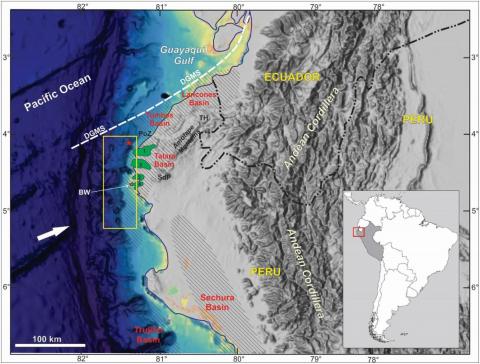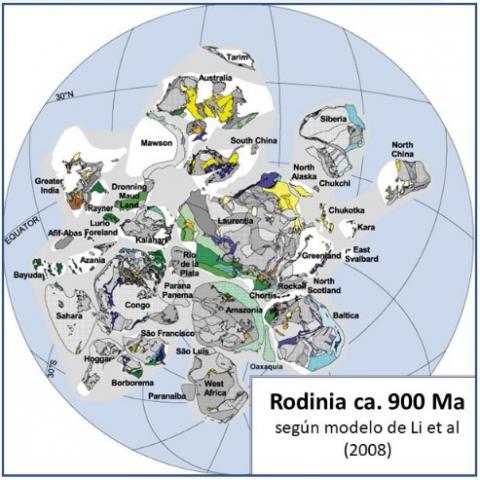The hydrocarbon potential of the offshore Talara Basin, Perú
Eduardo A. Rossello, Stephen P.J. Cossey, Guzmán Fernández
2 022
AndGeo vol.49 no.1 Santiago ene. 2022
La cuenca Talara costa afuera es la extensión occidental de su parte continental que contiene los campos petroleros productores de hidrocarburos desde mediados del siglo XIX en Perú. Esta se encuentra sobre la zona de subducción en el margen activo de los Andes, donde la placa oceánica de Nazca está subduciendo bajo la continental de América del Sur. La porción marina de la cuenca se evaluó utilizando un relevamiento sísmico 3D de alta calidad donde los horizontes de mapeo interpretados son discordancias dentro del Eoceno, así como del Paleoceno superior y el Cretácico Superior. Las posibles rocas generadoras son las lutitas marinas negras del Cretácico de la Formación Redondo (Campaniano), las calizas de la Formación Muerto (Albiano) y las lutitas marinas del Terciario temprano. Se propone que el objetivo principal de la exploración petrolera en alta mar sean las turbiditas de aguas profundas del Paleoceno/Eoceno originadas por aportes desde las tierras altas del noreste, creadas por la elevación compresiva de los Andes. Se considera que los principales sellos en el sector costa afuera sean lutitas de la Formación Lagunitos del Eoceno superior y las lutitas de la Formación Chacra, que también son sellos en el campo terrestre Litoral. El modelo de maduración térmica muestra que existen dos cocinas de hidrocarburos en la parte costa afuera de la cuenca, una en el norte y otra en el sur. La fuente probable del Cretácico alcanzó el inicio de la madurez (VR=0,63%) a una profundidad de 3.250 a 3.285 m (10.663-10.778 pies) entre 30 y 39 Ma (Eoceno tardío al Oligoceno). Es importante destacar que las rocas generadoras del Cretácico permanecen dentro de la ventana de petróleo al ingresar en el Eoceno tardío. Los estudios satelitales muestran una gran emanación actual de petróleo en alta mar, en la parte sur de la cuenca y la sísmica 3D presenta indicadores directos de hidrocarburos (DHI) en imágenes como puntos planos y reflectores de simulación de fondo (BSR). El modelado de cuencas sugiere que las vías de migración de los hidrocarburos habrían sido ascendentes hacia el este, en dirección a las trampas en tierra y, por lo tanto, habrían llenado primero las trampas en alta mar a lo largo de la vía de migración. Se concluye que la cuenca Talara costa afuera ofrece excelentes oportunidades de exploración en un área productiva probada donde se han identificado múltiples prospectos.
The offshore Talara Basin is the western extension of the hydrocarbon producing onshore fields since the mid-1800s area of Peru and is also located above the subduction zone of the active continental margin of South America. The offshore portion was evaluated using high quality 3D seismic where mapping horizons are all unconformities within the Eocene as well as the unconformities at the top Paleocene and top Cretaceous. Possible source rocks are the Cretaceous black marine shales of the Campanian Redondo Formation, the limestones of the Albian Muerto Formation, and the marine shales of the Paleogene. The primary target offshore is expected to be deep-water turbidites of Paleocene/Eocene age with a depositional source from the northeast from highlands created by the compressional uplift of the Andes. The main seals offshore are expected to be shales of the upper Eocene Lagunitos Formation and shales in the Chacra Formation, which are also seals in the onshore Litoral field. Thermal maturation modeling shows that two hydrocarbon kitchens exist in the offshore portion of the Talara basin, one in the north and another in the south. The probable Cretaceous source rocks reached the onset of maturity (VR=0.63%) at a depth of 3,250 to 3,285 m (10,663-10,778 ft) between 30 and 39 Ma (Late Eocene to Oligocene). Importantly, the Cretaceous source rocks stay within the oil window once they enter it in the late Eocene. Satellite studies show a large offshore present-day oil seep in the southern part of the basin and 3D seismic shows direct hydrocarbon indicators (DHIs) imaged as flat spots and bottom simulating reflectors (BSR). Basin modeling suggests hydrocarbon migration pathways would have been updip (to the east) into the onshore traps and would therefore have first filled the offshore traps along the migration pathway. We conclude that the Talara Basin offshore offers excellent exploration opportunities in a proven productive area where multiple prospects have been mapped.









